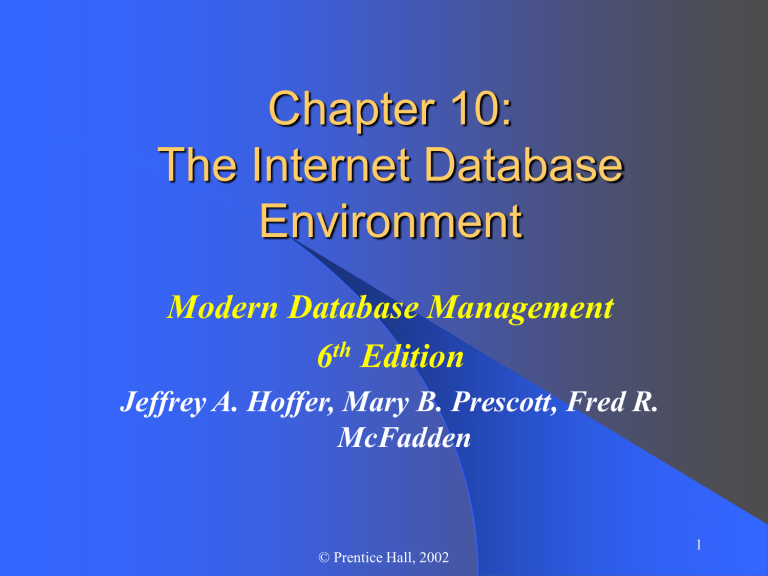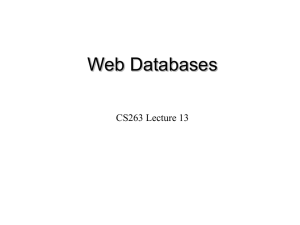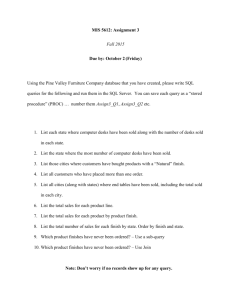CHAP10

Chapter 10:
The Internet Database
Environment
Modern Database Management
6
th
Edition
Jeffrey A. Hoffer, Mary B. Prescott, Fred R.
McFadden
© Prentice Hall, 2002
1
Figure 10-1: Database-enabled intranet-internet environment
Chapter 10
© Prentice Hall, 2002
2
Business on the Internet
Electronic Business (e-business)
– Development of integrated relationship with customers and suppliers via the Internet
– Business-to-Consumer (B2C) – retail
– Business-to-Business (B2B) – interaction with suppliers and vendors
Electronic Commerce (e-commerce)
– Business transactions, including:
Order processing/fulfillment
Customer relations
Electronic data interchange (EDI)
Bill payments
Chapter 10
© Prentice Hall, 2002
3
Web-Related Terms
World Wide Web (WWW)
– The total set of interlinked hypertext documents residing on Web servers worldwide
Browser
– Software that displays HTML documents and allows users to access files and software related to HTML documents
Web Server
– Software that responds to requests from browsers and transmits
HTML documents to browsers
Web pages – HTML documents
– Static Web pages – content established at development time
Dynamic Web pages – content dynamically generated, usually by obtaining data from database
Chapter 10
© Prentice Hall, 2002
4
Communications Technology
IP Address
– 4 numbers that identify a node on the internet
– E.g. 131.247.152.18
Hypertext Transfer Protocol (HTTP)
– Communication protocol used to transfer pages from Web server to browser
– HTTPS is a more secure version
Uniform Resource Locator (URL)
– Mnemonic Web address corresponding with IP address
– Also includes folder location and html file name
Figure 10-2:
Typical URL
Chapter 10
© Prentice Hall, 2002
5
Internet-Related Languages
Hypertext Markup Language (HTML)
– Markup language specifically for Web pages
Standard Generalized Markup Language (SGML)
– Markup language standard
Standards and Web
Extensible Markup Language (XML)
– Markup language allowing customized tags conventions established by
XHTML
– XML-compliant extension of HTML
World Wide Web
Consortium (W3C)
Java
– Object-oriented programming language for applets
JavaScript/VBScript
– Scripting languages that enable interactivity in HTML documents
Cascading Style Sheets (CSS)
– Control appearance of Web elements in an HML document
Chapter 10
© Prentice Hall, 2002
6
Web Servers
Provide HTTP service
Passing plain text via TCP connection
Serve many clients at once
– Therefore, multithreaded and multiprocessed
Load balancing approaches:
– Domain Name Server (DNS) balancing
One DNS = multiple IP addresses
– Software/hardware balancing
Request at one IP address is distributed to multiple servers
– Reverse proxy
Intercept client request and cache response
Chapter 10
© Prentice Hall, 2002
7
Server-Side Extensions
Programs that interact directly with Web servers to handle requests
e.g. database-request handling middleware
Figure 10-3: Web-to-database middleware
Chapter 10
© Prentice Hall, 2002
8
Client-Side Extensions
Add functionality to the browser
Plug-ins
– hardware./software modules that extend browser capabilities by adding features (e.g. encryption, animation, wireless access)
ActiveX
– Microsoft COM/OLE components that allow data manipulation inside the browser
Cookies
– Block of data stored at client by Web server for later use
Chapter 10
© Prentice Hall, 2002
9
Web Server Interfaces
Common Gateway Interface (CGI)
– Specify transfer of information between Web server and CGI program
– Performance not very good
– Security risks
Application Program Interface (API)
– More efficient than CGI
– Shared as dynamic link libraries (DLLs)
Java Servlets
– Like applets, but stored at server
–
–
Cross-platform compatible
More efficient than CGI
Chapter 10
© Prentice Hall, 2002
10
Web-to-Database Tools
Active Server Pages (ASP)
– Microsoft server-side scripting language
–
–
Generates dynamic Web pages
Interfaces to databases in MS Windows-based Web servers
Cold-Fusion
– Uses special server-side markup language CFML
–
–
Modeled after HTML
Interfaces to databases
Embedded SQL
– SQL embedded in 3GL programs
–
–
–
Provides flexible interface
Improves performance
Improves database security
Chapter 10
© Prentice Hall, 2002
11
Figure 10-4: A global.asa
file for an ASP application
ASP applications include HTML extensions and additional scripting
(usually in VBScript, or in JavaScript)
ASP code embedded in <% %> tags are executed on the server, instead of the client. This is how dynamic Web pages can be created
Chapter 10
© Prentice Hall, 2002
12
Sample ASP Code
(from Figure 10-5 Box E and F)
<%
REM Get list of Finishes strSQL = “SELECT Product_Finish FROM PRODUCT_t GROUP BY Product_Finish;”
Set rsRes = con.Execute(strSQL)
%>
<TABLE>
<%
REM Display the list of finishes
While not rsRes.EOF
%>
<TR>
<TD align=center valign=top>
<%=rsRes(“Product Finish”>)%></TD>
<TD>
<FORM method=post action=“line.asp”>
<INPUT type=Hidden name=line value=“<%=rsRes(“Product_Finish”))%>
<INPUT type=submit Value=GO!>
</TD>
</TR>
<% rsRes.MoveNext
Wend
%>
</TABLE>
Chapter 10
© Prentice Hall, 2002
13
Sample ASP Code
(from Figure 10-5 Box E and F)
<%
REM Get list of Finishes strSQL = “SELECT Product_Finish FROM PRODUCT_t GROUP BY Product_Finish;”
Set rsRes = con.Execute(strSQL)
%>
<TABLE>
<%
REM Display the list of finishes
While not rsRes.EOF
%>
<TR>
<TD align=center valign=top>
<%=rsRes(“Product Finish”>)%></TD>
<TD>
<FORM method=post action=“line.asp”>
Code is within the <% %> tags are executed on the server, not the client…these are interacting with the database and creating dynamic Web content
<INPUT type=Hidden name=line value=“<%=rsRes(“Product_Finish”))%>
<INPUT type=submit Value=GO!>
</TD>
</TR>
<% rsRes.MoveNext
Wend
%>
</TABLE>
Chapter 10
14
© Prentice Hall, 2002
Sample ASP Code
(from Figure 10-5 Box E and F)
<%
REM Get list of Finishes strSQL = “SELECT Product_Finish FROM PRODUCT_t GROUP BY Product_Finish;”
Set rsRes = con.Execute(strSQL)
%>
<TABLE>
<%
REM Display the list of finishes
While not rsRes.EOF
%>
<TR>
These lines are executing a query on the database server using a middleware called Active Data Objects (ADO).
The con variable is a connection to the database, which was established in the code of Box C. The rsRes variable contains the result set of the query (the rows returned from the query)
<TD align=center valign=top>
<%=rsRes(“Product Finish”>)%></TD>
<TD>
<FORM method=post action=“line.asp”>
<INPUT type=Hidden name=line value=“<%=rsRes(“Product_Finish”))%>
<INPUT type=submit Value=GO!>
</TD>
</TR>
<% rsRes.MoveNext
Wend
%>
</TABLE>
Chapter 10
15
© Prentice Hall, 2002
Sample ASP Code
(from Figure 10-5 Box E and F)
<%
REM Get list of Finishes strSQL = “SELECT Product_Finish FROM PRODUCT_t GROUP BY Product_Finish;”
Set rsRes = con.Execute(strSQL)
%>
<TABLE>
<%
REM Display the list of finishes
While not rsRes.EOF
%>
<TR>
These lines of code cause the ASP application to loop through the rows returned by the query until they reach the end
<TD align=center valign=top>
<%=rsRes(“Product Finish”>)%></TD>
<TD>
<FORM method=post action=“line.asp”>
<INPUT type=Hidden name=line value=“<%=rsRes(“Product_Finish”))%>
<INPUT type=submit Value=GO!>
</TD>
</TR>
<% rsRes.MoveNext
Wend
%>
</TABLE>
Chapter 10
© Prentice Hall, 2002
16
Sample ASP Code
(from Figure 10-5 Box E and F)
<%
REM Get list of Finishes strSQL = “SELECT Product_Finish FROM PRODUCT_t GROUP BY Product_Finish;”
Set rsRes = con.Execute(strSQL)
%>
<TABLE>
<%
REM Display the list of finishes
While not rsRes.EOF
%>
<TR>
These lines of code are retrieving the values of the specified field from the current row of the query result
<TD align=center valign=top>
<%=rsRes(“Product Finish”>)%></TD>
<TD>
<FORM method=post action=“line.asp”>
<INPUT type=Hidden name=line value=“<%=rsRes(“Product_Finish”))%>
<INPUT type=submit Value=GO!>
</TD>
</TR>
<% rsRes.MoveNext
Wend
%>
</TABLE>
Chapter 10
© Prentice Hall, 2002
17
Sample ASP Code
(from Figure 10-5 Box E and F)
<%
REM Get list of Finishes strSQL = “SELECT Product_Finish FROM PRODUCT_t GROUP BY Product_Finish;”
Set rsRes = con.Execute(strSQL)
%>
<TABLE>
<%
REM Display the list of finishes
While not rsRes.EOF
%>
<TR>
The Web page is being dynamically created, with one
HTML table row for each record obtained from the query.
Also, each Web table row includes a button that will link to another ASP page
<TD align=center valign=top>
<%=rsRes(“Product Finish”>)%></TD>
<TD>
<FORM method=post action=“line.asp”>
<INPUT type=Hidden name=line value=“<%=rsRes(“Product_Finish”))%>
<INPUT type=submit Value=GO!>
</TD>
</TR>
<% rsRes.MoveNext
Wend
%>
</TABLE>
Chapter 10
18
© Prentice Hall, 2002
Figure 10-8: Processing an embedded SQL program
Embedded SQL statement begins with EXEC SQL
Chapter 10
Precompiler translates embedded SQL into host program language
Compiler and linker generate executable code
19
© Prentice Hall, 2002
Managing Website Data
Web Security Issues
– Prevent unauthorized access and malicious destruction
Privacy Issues
– Protect users’ privacy rights
Internet Technology Rate-of-Change Issues
– Deal with rapid advances in technology
Chapter 10
© Prentice Hall, 2002
20
Website Security
Planning for Web Security
– Risk assessment: nature, likelihood, impact, and motivation of security risks
Network Level Security
– Web server and DB server on separate LAN from other business systems
–
–
–
Minimize sharing of hard disks among network servers
Regular monitoring of network and firewall logs
Install probe-monitor software
Chapter 10
© Prentice Hall, 2002
21
Website Security (continued)
Operating System Level Security
– Patch all known OS vulnerabilities
– Install anti-virus software with boot-time, file download time, and email reception time virus detection
– Monitor server logs for unauthorized activity
– Disable unrequired services to reduce risk of unauthorized access
Chapter 10
© Prentice Hall, 2002
22
Web Security (continued)
Web Server Security
– Restrict number of users on Web server
– Restrict access (minimize number of open ports)
http and https only, if possible
– Remove unneeded programs
Restrict CGI scripts to one subdirectory
– For Unix, only install minimum software for
Web server
Chapter 10
© Prentice Hall, 2002
23
Website Security (continued)
Firewall – hardware/software security component that limits external access to company’s data
Proxy server
– firewall component that manages
Internet traffic to and from a LAN
Router
– intermediate device that transmits message packets to correct destination over most efficient pathway
Intrusion detection system (IDS)
– system that identifies attempt to hack or break into a system
Chapter 10
© Prentice Hall, 2002
24
Figure 10-9: Establishing Internet security
Routers to transmit message packets to correct destination
Chapter 10
Firewall to limit external access to data
IDS to monitor and recognize security breach attempts
25
© Prentice Hall, 2002







